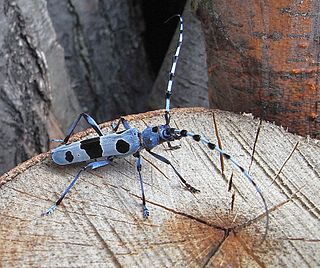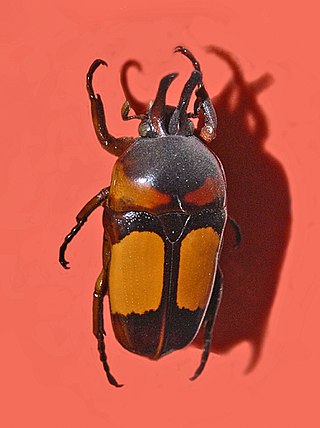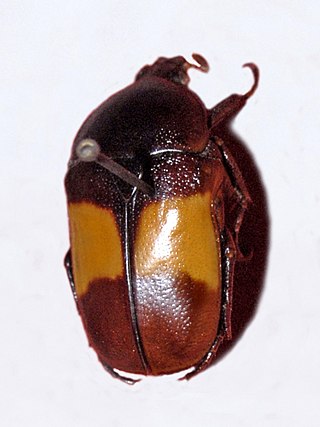
The family Scarabaeidae, as currently defined, consists of over 30,000 species of beetles worldwide; they are often called scarabs or scarab beetles. The classification of this family has undergone significant change in recent years. Several subfamilies have been elevated to family rank, and some reduced to lower ranks. The subfamilies listed in this article are in accordance with those in Bouchard (2011).

Antennae, sometimes referred to as "feelers", are paired appendages used for sensing in arthropods.

Dung beetles are beetles that feed on feces. Some species of dung beetles can bury dung 250 times their own mass in one night.

Trogidae, sometimes called hide beetles, is a family of beetles with a distinctive warty or bumpy appearance. Found worldwide, the family includes about 300 species contained in four or five genera.

Dynastinae or rhinoceros beetles are a subfamily of the scarab beetle family (Scarabaeidae). Other common names – some for particular groups of rhinoceros beetles – include Hercules beetles, unicorn beetles or horn beetles. Over 1500 species and 225 genera of rhinoceros beetles are known.

Allomyrina dichotoma, also known as Japanese rhinoceros beetle, Japanese horned beetle, or kabutomushi (カブトムシ), is a species of rhinoceros beetle.

Metarhizium robertsii – formerly known as M. anisopliae, and even earlier as Entomophthora anisopliae (basionym) – is a fungus that grows naturally in soils throughout the world and causes disease in various insects by acting as a parasitoid. Ilya I. Mechnikov named it after the insect species from which it was originally isolated – the beetle Anisoplia austriaca. It is a mitosporic fungus with asexual reproduction, which was formerly classified in the form class Hyphomycetes of the phylum Deuteromycota.

The scarab beetle subfamily Scarabaeinae consists of species collectively called true dung beetles. Most of the beetles of this subfamily feed exclusively on dung. However, some may feed on decomposing matter including carrion, decaying fruits and fungi. Dung beetles can be placed into three structural guilds based on their method of dung processing namely rollers, dwellers and tunnelers Dung removal and burial by dung beetles result in ecological benefits such as soil aeration and fertilization; improved nutrient cycling and uptake by plants, increase in Pasture quality, biological control of pest flies and intestinal parasites and secondary seed dispersal. Well-known members include the genera Scarabaeus and Sisyphus, and Phanaeus vindex.

Melolonthinae is a subfamily of the scarab beetles. It is a very diverse group; distributed over most of the world, it contains over 11,000 species in over 750 genera. Some authors include the scarab subfamilies Euchirinae and Pachypodinae as tribes in the Melolonthinae.

Xylotrupes gideon, the brown rhinoceros beetle, is a species of large scarab beetle belonging to the subfamily Dynastinae.

Anoplognathus viridiaeneus, commonly known as the king Christmas beetle, is a beetle of the family Scarabaeidae native to eastern Australia. The largest Christmas beetle, it can be over 3 centimetres (1.2 in) long.

Pelidnota burmeisteri is a species of beetles of the family Scarabaeidae.

Pelidnota virescens is a species of beetle of the family Scarabaeidae.

Dicheros bicornis is a species of beetles belonging to the family Scarabaeidae, subfamily Cetoniinae.

Heterorhabditis megidis is a species of nematodes in the genus Heterorhabditis. All species of this genus are obligate parasites of insects, and some are used as biological control agents for the control of pest insects.

Chondrorrhina abbreviata is a species of fruit and flower chafers belonging to the family Scarabaeidae, subfamily Cetoniinae.

Chondrorrhina is a genus of fruit and flower chafers belonging to the family Scarabaeidae, subfamily Cetoniinae.

Anoplognathus brunnipennis, commonly known as the brown- or golden-brown Christmas beetle, is a beetle of the family Scarabaeidae native to eastern Australia, being common in coastal Queensland, New South Wales and Victoria, the Great Dividing Range and the Murray-Darling river basin.
Rutelini is a tribe of shining leaf chafers in the family Scarabaeidae. There are about 14 genera and at least 40 described species in Rutelini.
Garreta smaragdifer is a species of dung beetle native to India and Sri Lanka.

















